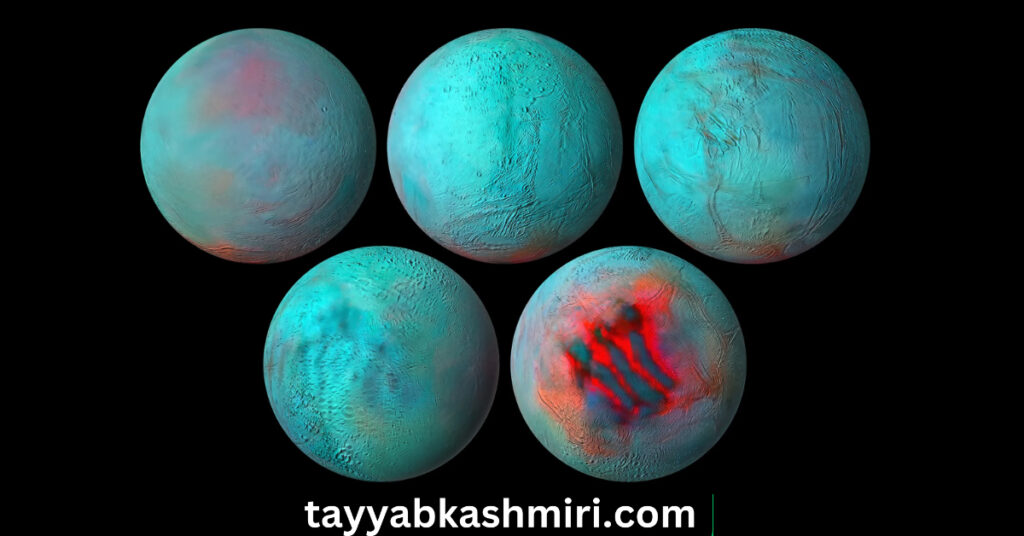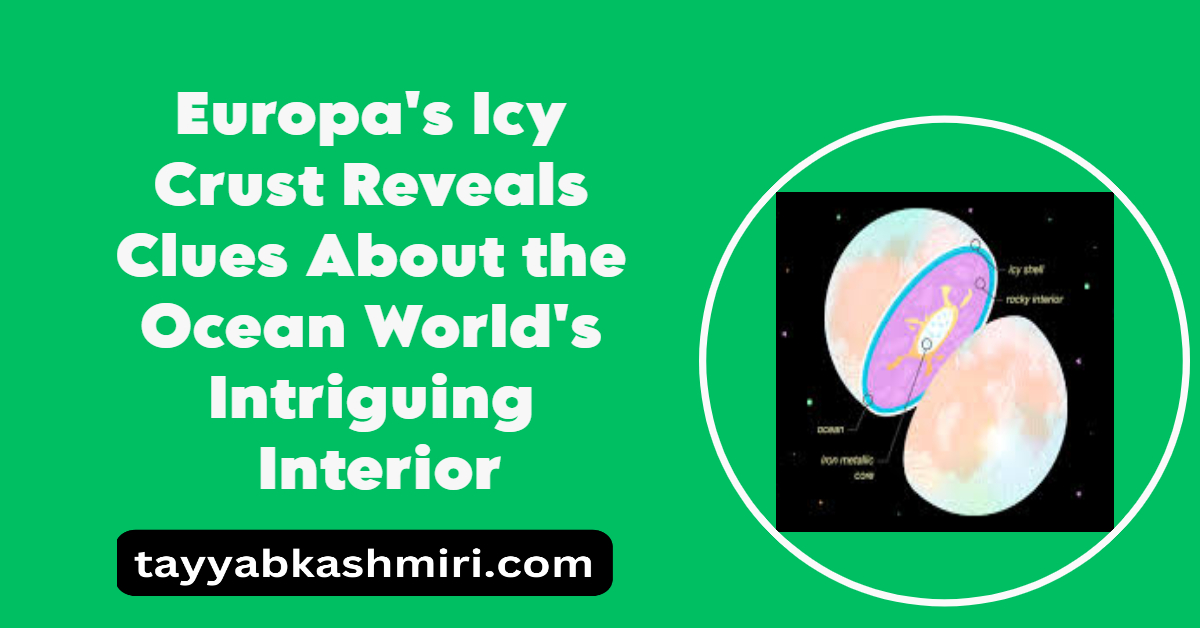Europa’s Icy Crust Reveals Clues About the Ocean World’s Intriguing Interior

Table of Contents
For More Articles : Visit Here
Landmarks on Europa Suggest Subsurface Water Influences Surface
Landmarks on Europa’s surface suggest that the icy crust is influenced by the waters below. Most importantly, a recent visit by NASA’s Juno spacecraft reveals potential plume activity on Europa, which, if confirmed, would allow future missions like the upcoming Europa Clipper to sample the internal ocean without landing.
Juno’s Close Approach Provides First Close-ups Since Galileo
It has been almost two years since Juno made its closest approach to Europa in September 2022, but its observations are still being analyzed. Remarkably, despite orbiting Jupiter since 2016, Juno’s five images taken on September 29, 2022 were the first close-ups of Europa since the Galileo spacecraft’s last visit in 2000.
This could be seen as neglecting one of the solar system’s most intriguing worlds, but it might also have provided a long baseline to observe changes on the icy moon’s surface over time.
Europa’s Surprisingly Dynamic Surface
Europa is the smoothest object in the solar system, thanks to constant resurfacing driven by its internal ocean. Nevertheless, it is far from featureless. Juno spotted some steep-walled depressions 12 to 31 kilometers wide and fracture patterns thought to indicate “true polar wander.”
What is True Polar Wander?
“True polar wander occurs if Europa’s icy shell is decoupled from its rocky interior, resulting in high stress levels on the shell, which lead to predictable fracture patterns,” said Dr. Candy Hansen of the Planetary Science Institute.
The idea behind true polar wander is that the shell on top of Europa’s internal ocean is rotating at a different rate from the rest of the moon. It is thought the water below is moving and dragging the shell with it, with currents within the ocean affecting the shell’s movements. These currents are presumably driven by heating within Europa’s rocky core as the gravitational pull of Jupiter and the larger moons turn Europa into a giant stress ball.
Mapping Changes on Europa’s Surface

Hansen is part of a team exploring Juno’s images of Europa’s southern hemisphere. “This is the first time that these fracture patterns have been mapped in the southern hemisphere, suggesting that true polar wander’s effect on Europa’s surface geology is more extensive than previously identified,” she said.
Not all changes to Europa’s maps are the result of internal ocean currents. It seems even NASA can fall for optical illusions. “Crater Gwern is no more,” said Hansen. “What was once thought to be a 21-kilometer-wide impact crater — one of Europa’s few documented impact craters — Gwern, was revealed in JunoCam data to be a set of intersecting ridges that created an oval shadow.”
The “Platypus” Formation
However, Juno is revealing more than it takes away. The team is excited by something they are calling the “Platypus” due to its shape. Ridge formations at its edge appear to collapse into it, and the team thinks this process could be caused by pockets of salt water that have partially penetrated the icy shell.
Such pockets would be exciting indirect targets for study by the Europa Clipper, but more interesting still are dark stains that may have been deposited by cryovolcanic activity.
Potential for Present-Day Plume Activity
“These features hint at present-day surface activity and the presence of subsurface liquid water on Europa,” said Heidi Becker of the Jet Propulsion Laboratory. Such activity has been confirmed in the geysers of Enceladus, but there is conflicting evidence of whether it is currently occurring on Europa.
Such plume activity would make it possible to sample the interior ocean for signs of life just by flying through a plume and collecting some ice flakes, without having to land or drill through the thick ice shell.
Evidence of Ancient Pole Shifts
Currently, any true polar wander on Europa might only cause quite modest adjustments to the locations of surface features. However, there is evidence that millions of years ago, a massive polar shift of more than 70 degrees took place on Europa, likely shifting the locations of oceans, ice shells, and geological features in a dramatic way – though the reasons for such an extreme event are still unknown.
By studying these ancient shifts, scientists hope to gain insights into the dynamics, history and formation of Europa’s internal ocean, icy shell, and potential for hosting life over the vast timescales of the solar system’s evolution.
Excitement Building for Europa Clipper
Overall, the new observations from Juno have given planetary scientists an unprecedented look at Europa’s intriguing surface geology and potential for plume activity. However, the Europa Clipper orbiter, set to launch in the mid-to-late 2020s, will take the investigation to a whole new level.
The highly capable Clipper spacecraft will spend years making numerous close flybys of Europa, equipped with ice-penetrating radar, high-resolution cameras, spectrometers, and other instruments designed to scout for promising future landing sites and study the moon’s ocean, ice shell, geology and potential habitability in incredible detail.
For many planetary scientists, Europa represents one of the best chances we have of finding life elsewhere in our solar system. The excitement is building to see what the Clipper spacecraft reveals about this enigmatic ocean world after arriving at Jupiter in the late 2020s or early 2030s.
Europa’s Composition and Internal Structure
While Europa is known to have a subsurface ocean underneath an icy shell, scientists are still working to determine the specifics of its internal structure and composition based on magnetic data, gravity measurements, and other observations.
Early models suggested Europa likely has an iron-nickel core surrounded by a rocky mantle, with the ocean existing in the outer shell region. However, more recent evidence indicates Europa’s ocean could extend much deeper, perhaps surrounding the entire core itself.
A Global Ocean World?
Some planetary scientists think Europa may not have a dense, rocky mantle at all, but is instead a ocean world with relatively little solid surface compared to the global liquid ocean below. In this scenario, the moon is basically a large salt-water basin encased in an icy shell, with water making up most of its interior.
If proven true, this global ocean model would have significant implications for Europa’s habitability and ability to sustain life, as the liquid water reservoir would be vastly larger than previously thought.
Measuring Ocean Depth and Salinity
Determining the true depth and salinity of the ocean will be a major goal for instruments like ice-penetrating radar when the Europa Clipper arrives. Greater saltiness could allow the ocean to remain liquid at colder temperatures over geological timescales.
Salts and other minerals from hydrothermal vents may also enrich the ocean’s composition with compounds like dissolved sodium, chlorides, carbonates and sulfates – potentially providing energy sources for any microbial lifeforms that may exist.
Landing on Europa – Robotic and Human Missions
While the Europa Clipper orbiter will provide unprecedented data, it is limited to flybys and remote sensing from afar. To truly reveal if life exists within Europa’s ocean, future robotic landers and even human missions may eventually be needed.
Challenges of Landing on Europa
Landing a robot on Europa’s icy surface would be enormously challenging due to the harsh radiation environment from Jupiter’s magnetic belts, the lack of atmospheric braking, and the need for robust systems to drill or melt through the thick ice to access the ocean below.
Additionally, any microbes within the ocean could potentially be transported to other worlds via landing craft, so rigorous planetary protection protocols would be needed to avoid forward contamination.
Potential for Human Exploration
Despite the difficulties, some have proposed that human exploration of Europa’s surface and ocean could be possible later this century with rigorous shielding, in-situ propellant production, and next-generation spacecraft and landers.
Astronauts could deploy more capable probes through the ice and directly collect ocean samples, while also searching for any macroscopic lifeforms that may exist. A human presence could also help confirm plumes and quickly react to any dynamic processes observed on Europa.
However, such missions remain sci-fi for now. Robotic probes like the Clipper are the main near-term focus to determine if Europa shows definitive signs of life first.
Managing Planetary Protection
Speaking of spacecraft impacting and potentially contaminating Europa’s ocean environment, NASA and other space agencies are working proactively on planetary protection guidelines.
Forward and Backwards Contamination
There are two main issues – avoiding “forward contamination” of potentially carrying terrestrial microbes to Europa, and preventing “backward contamination” of any samples collected eventually making their way back to Earth’s biosphere.
NASA has requirements for any Europa mission to be rigorously decontaminated before launch. And samples would need to be contained and analyzed with extreme care, following protocols similar to dealing with extraterrestrial material from Mars or other bodies.
Ethics Considerations
There are also ethical questions around whether it is right to sacrifice Europa’s ocean to science if life does exist there. Some have proposed simply orbiting and studying Europa from afar with minimal impact as a possible compromise.
Ultimately, protocols, procedures and ethical guidelines will evolve as our understanding of Europa progresses and the prospects of directly accessing its ocean environment become more viable. Protecting both Earth and Europa’s environments will be of paramount importance.
Overall, the coming years and decades promise to significantly advance our knowledge of this tantalizing ocean world and its potential as an inhabited environment through robotic and perhaps even human explorers. Europa beckons as one of the most compelling places to go in search of alien life.
Analogues for Europa’s Ocean on Earth
As scientists prepare to explore Europa’s ocean environment, they are studying analogous environments on Earth to better understand what kinds of life could potentially exist on the icy moon.
Subglacial Antarctic Lakes
One of the closest analogues may be the subglacial lakes found underneath the Antarctic ice sheet, like Lake Vostok. These lakes contain liquid water trapped under miles of ice, kept from freezing by heat from the Earth’s interior.
Despite the extreme cold, nutrient-depleted conditions, these subglacial Antarctic lakes may harbor microbial lifeforms that could provide clues to what simple organisms might inhabit Europa’s ocean as well, metabolizing inorganic compounds rather than organic sources.
Deep Ocean Hydrothermal Vents
Another compelling analogue environment is the deep ocean hydrothermal vent systems found along mid-ocean ridges and tectonic spreading zones. Superheated, mineral-laden water erupts from the seafloor, allowing chemosynthetic life to thrive without sunlight.
On Europa, scientists suspect similar hydrothermal systems could be active on the seafloor of its subsurface ocean, providing oases for life by venting chemicals that could be metabolized by alien microbes. Studying vent organisms could reveal evolutionarily streamlined microbes that might resemble life on Europa.
Could Higher Life Forms Exist?
Most models of potential life on Europa envision only single-celled microorganisms, given the likely nutrient-starved conditions. However, some have speculated that more complex, multicellular lifeforms could hypothetically evolve over billions of years.
Complex Life in Europa’s “Soups”?
On Earth, complex multicellular life only emerged after oxygenation of the atmosphere and oceans allowed sufficient energy availability. But in Europa’s alien ocean “soups” cycling chemical energy from hydrothermal systems, who’s to say complex life couldn’t evolve an alternative biochemistry and means of growth given 4+ billion years?
While considered unlikely by most experts, science fiction has envisioned scenarios where larger, mobile lifeforms – akin to complex ocean filter feeders or predators – could arise in Europa’s potentially vast seafloor ecosystems. We may have to explore Europa thoroughly to rule such possibilities out entirely.
Looking for Biological Complexity
The Europa Clipper’s instruments are primarily designed to hunt for minimal signs of basic life like methane, organic compounds or microbial cells and structures. However, more capable future landers may be able to detect any more complex biological patterns, structures or processes that could hint at higher forms of life, should they exist.
Ground-penetrating radar could potentially detect larger life forms or colonies, and other methods could look for directed movements, biological circadian rhythms or other higher-level signatures that microbes alone shouldn’t create. While a long shot, the search for complex extraterrestrial biology on Europa adds intrigue.
Europa’s Ocean in the Search for Life’s Origins
Beyond sheer exploration and discovery, scientists are also motivated to explore Europa’s ocean as it could provide a window into how life first emerged in our solar system and perhaps the universe.
An Alien Genesis?
By studying the conditions, chemistry and any biological processes within Europa’s alien ocean environment, astrobiologists hope to detect potentially primordial forms of life and better understand what kick-started the origin of life on the early Earth or other solar system bodies.
Did life emerge quickly once the right biochemical conditions arose? Or was there a long, circuitous path of chemical evolution first? Could entirely different forms of life operate with alternative biochemistries?
Comparing Life’s “Nursery”
Comparing any lifeforms found on Europa to life on Earth could reveal if both emerged from a common primordial genesis billions of years ago, or if they evolved separately via different pathways – a key question in determining how frequently abiogenesis may occur.
While the waters of Europa are likely too cold to support life similar to Earth’s, the subsurface ocean could have remained a warm, protective “nursery” environment ripe for primitive life to take root if the conditions were right.
The Ultimate Origin Question
By studying Europa, scientists hope to not just detect biosignatures of life, but potentially reveal its origins – providing key evidence about the fundamental requirements and pathways life may have taken on the early Earth, Europa, or elsewhere in the cosmos.
The data could help discern if life is a freak rarity, or perhaps an emerging universal pattern written into the laws of nature and chemistry under the right conditions. Solving this profound mystery is a key motivation for Europa exploration.
Wherever the evidence may lead, the revelations about life’s origins promised by missions to Europa will fundamentally expand the understanding of our place in the universe and what the future may hold as humanity extends its reach to the stars.
Free Earn Money Online: Visit Here
Frequently Asked Questions About Europa
Does Europa definitely have a subsurface ocean?
While not confirmed visually, scientists are highly confident that Europa has a global subsurface ocean based on several lines of evidence: Europa’s icy surface exhibits patterns and features that suggest the presence of an ocean below, including cracks, ridges, and chaos terrain. Measurements of Europa’s magnetic field and gravity data indicate the moon likely has a liquid ocean underneath its icy shell. Theoretical models of tidal heating from Jupiter suggest Europa should be warm enough internally to maintain a subsurface ocean.
How deep is Europa’s ocean estimated to be?
Most models suggest Europa’s ocean could be anywhere from 60-200 km (40-125 miles) deep, with a relatively thin icy shell on the surface between 10-30 km (6-19 miles) thick. However, the exact depths are still unknown and will be a focus of study for the upcoming Europa Clipper mission.
Is Europa’s ocean frozen solid now or still liquid?
Scientists believe Europa’s ocean has likely existed for most of the moon’s 4.5 billion year lifetime and remains liquid today, based on the lack of evidence for complete ice shell freezing over time. However, tidal forces from Jupiter provide a continual source of heat to prevent the ocean from freezing entirely.
What is the composition of Europa’s ocean?
While its exact composition is uncertain, the leading hypothesis is that Europa’s subsurface ocean is a cold, salty ocean composed primarily of liquid water but with potential dissolved salts like sulfates, carbonates, and chlorides from hydrothermal vents. This salinity may allow the ocean to remain liquid at colder temperatures.
Could life exist in Europa’s ocean?
Many astrobiologists consider Europa one of the most potentially habitable environments in our solar system for simple forms of life. Its subsurface ocean could provide the three ingredients needed for life as we know it: liquid water, chemistry providing energy sources, and raw materials like carbon, nitrogen, oxygen, and other elements.
How would we detect life in Europa’s ocean?
There are a few potential methods that could provide evidence of life in Europa’s ocean: Directly sampling ocean material from future landers/probes Analyzing plume deposits on Europa’s surface for biosignatures Looking for chemical disequilibrium in the ocean’s composition Detecting biological products/byproducts like methane Identifying potentially biological structures or patterns The Europa Clipper will make initial efforts to assess Europa’s habitability potential.
When will we humans actually explore Europa’s ocean?
While exciting, directly exploring Europa’s ocean environment is still likely decades away. The Europa Clipper will conduct multiple flybys in the late 2020s/early 2030s, followed by future landers designed to penetrate the ice shell. Eventual human exploration remains speculative but may be possible later this century if the conditions are right.
Could Europa’s ocean contain larger lifeforms?
Most scientists think any life in Europa’s ocean would likely be limited to single-celled microorganisms, given the expected nutrient scarcity and cold conditions. However, some have speculated that more complex, multicellular lifeforms may be possible if the ocean environment is richer and warmer than expected.
What’s the value in exploring Europa’s ocean?
Beyond sheer exploration, studying Europa’s ocean could provide valuable insights into: How life first emerged on Earth or elsewhere Conditions required for life to exist elsewhere Origin and evolutionary pathways of different biochemistries Development of habitable environments over time Europa provides a unique window into one of the fundamental mysteries of our cosmos. Let me know if you need any clarification or have additional questions!








